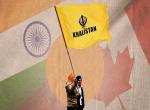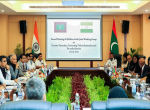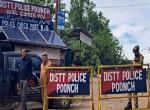In a recently concluded three-day visit of the Indian Defence Minister, A. K. Antony to Malé, India and Maldives have agreed to work together to ensure that “the stability in the region is maintained; and above all… threats, particularly from terrorist groups and other non-state actors, are eliminated”. What “terrorist groups and other non-state actors” were they talking about? Are the threats grave enough to merit structured bilateral counter-terrorism cooperation between the two countries?
Maldives, although a 100 percent Sunni nation, was considered to be not much affected by the rise of Islamic radicalism. However, in the recent years, Maldivians in increasing numbers have been drawn towards the Pakistan-based madrasas and jihadist groups. The Lashkar-e-Taiba (LeT), through its charitable front organisation in the atoll – Idara Khidmat-e-Khalq – has established a foothold in the southern parts of Maldives. This was achieved under the guise of providing relief operations after the 2004 tsunami. At any given point in time, there are over 50 Maldivian nationals studying in Pakistani madrasas which are controlled by various jihadist groups. There are several enrolled in Saudi Arabian madrasas as well, who, on their return, bring back not only the virus of radical ideas, but they also have increased opportunities to become part of jihadist networks. These madrasa-educated Maldivian nationals are encouraged to fight the jihad in places like Afghanistan, Iraq and Chechnya. They also help in the direct recruitment of Maldivian citizens for jihad. It is worth noting that the terrorist, Ali Jaleel, who was involved in 27 May 2009 suicide attack on the ISI headquarters in Lahore, was a Maldivian national.
It is not surprising therefore that the events in West Asia, Afghanistan and Pakistan have influenced the youth towards the process of radicalisation that emanated from inadequate educational and employment opportunities. The current rate of unemployment of Maldives stands at over 14 percent. The violent manifestation of radicalisation in the form of first-ever terror attack in September 2007 at Sultan Park of its capital Malé, left 12 injured and came as a jolt to the generally peace-loving Maldivians. Investigations of the attack indicated that the Jamaat-ul-Muslimeen, a new Maldives-based terror group, having links with the LeT was the mastermind. This incident worried the government as the economy heavily depends on tourism and terrorist attacks would curtail the earnings from this sector and cripple the economy. What is more worrying for India is the infiltration of Indian terror group Students Islamic Movement of India (SIMI) to Maldives, especially after its crackdown in India.
The Maldivian government under Mohammed Nasheed resorted to some stern measures to tone down the radicalisation through regulating local madrasas and seminaries. All mosques were required to register with the Ministry of Islamic Affairs and those which were unregistered were declared to be “Illegal” and even dismantled. The raid on Dhar-ul-Khair mosque in Himandhoo Island in October 2007 was a case in point. The government also tightened the visa regime to help prevent foreign Islamic clerics from teaching in the local madrasas. But, these measures did not go down well with the radicals. One of the principal reasons for Nasheed’s eventual ouster was his anti-radicalisation stance.
The crucial question then is why is Maldives considered suitable by terror groups like the LeT? There are several reasons for this; Maldives is a 100 percent Sunni Muslim country with a population of about 380,000. It is made up of 1192 small islands (grouped into 26 natural atolls), most of them uninhabited, spread across over 860 kilometers in a north-south axis; anonymity, therefore, is not an issue. The island-state is also not too far from India’s southern coast making it an ideal launch pad for attacks through sea. Pakistan-based terror groups know very well that launching the next attack on India from Pakistan would be difficult due to tightened security on the land and maritime boundaries. The LeT has plans to use the deserted Maldivian islands as storehouses for weapons and explosives and move them to India when required. These islands are also ideal for establishing training facilities, especially on the maritime front. The Maldivians’ superior knowledge of the sea is an asset to any terror group planning to carry out maritime terrorist attacks.
It is in this context counter-terrorism cooperation between India and Maldives gains significance. The existence of any terror bases or breeding grounds for terrorism in the Indian neighbourhood threatens Indian security. India cannot remain a mute spectator. Though, India and Maldives have been conducting joint counter-terrorism exercises on regular basis, it is not enough. There is an urgent need for structured counter-terrorism cooperation between the two maritime neighbours. The structure could include counter-terrorism training and capacity building, handing over of fugitives, sharing of intelligence, investigative assistance, joint-patrolling and maritime security. On its part, the Maldives, which is now under a new government, should deal with the issue of radicalisation more seriously. India can consider helping Maldives by creating more educational and vocational institutions so as to provide a viable alternative to Maldivian students over the madrasa option. India can also attract a sizeable number of the Maldivian students to its educational institutions through the liberal dispensation of scholarships. Apart from investing in Maldives, New Delhi can also encourage its businessmen and industry to set up joint ventures in the islands. The setting up of anti-terror measures and sharing of information with the Maldives are critical to India’s safety and internal security.
Published Date: 27th September 2012









Post new comment